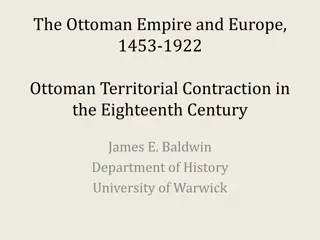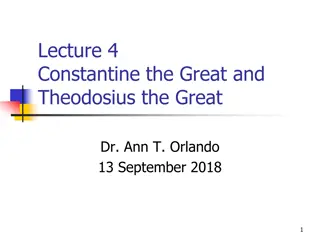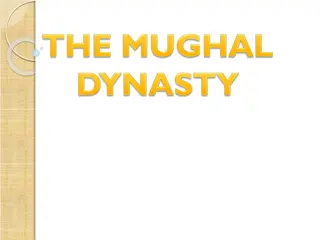Societal Organization and Administration in Chola Empire
The Chola Empire during the 9th to 10th centuries introduced social reforms, established a structured administrative system from provinces to villages, emphasized village administration, promoted temple construction and Brahmin settlements, and integrated temples into society, providing employment and societal cohesion.
Download Presentation

Please find below an Image/Link to download the presentation.
The content on the website is provided AS IS for your information and personal use only. It may not be sold, licensed, or shared on other websites without obtaining consent from the author. Download presentation by click this link. If you encounter any issues during the download, it is possible that the publisher has removed the file from their server.
E N D
Presentation Transcript
Introduction During the middle period of the 9thCentury, Vijayalaya founded a powerful empire Their successors especially Rajaraja and Rajendra. In the beginning of the 10thCentury the Chola monarchs introduced a series of social reforms for the benefit of the people as a whole. They divided the kingdom into provinces. Provinces were divided into districts and districts were divided into taluks. Each taluk was divided into villages. Villages had separate councils to administer.
Elected assembly existed in the villages. So village administration figured as the primary administrative unit of the Cholas. the Indian Government follows this principle of the Cholas in giving importance to the villagers. Society The Chola ruler were Hindus. They followed the the tradition of Pallavas and enforced the Varnasiramadharma in their country. They constructed temple based on agams. Vijayalaya constructed the temple as part of his administration and donated wealth in the form of money or land.
They considered it as a service to god and religion. The land donated to the temple appointed to conduct regular religious ceremonies. The rulers spent of major state income for construct of temple. The revenue of the temple lands was kept preserved in it. It acted as landlord and treasury.
Brahmins position Brahmins became stronger, during this period the temples were increased, it required the service of more Brahmins. Brahmins were invited from Northern part of India to settle permanently in the Chola kingdom. Brahmins from Telungu, Kannada, Mysore, Gujarat ,etc. Special grant were awarded for their settlement. The grants were called Brahmadanam land. The villages inhabited by Brahmins were called Chadurvedimangalam . it was also known as Mangalam, Agaram, Brahmapuram, Agraharam, Agara Brahmadeya, Agara- Brahmadesa, Brahamadesam and Brahmamangalam.
These lands were exempted from taxation. An important of Kulothunga I mentioned an endowment for the feeding the Brahmins on noon day. They were treated as highcaste in the society. Most of the settlements existed in and around the temple. The Brahmins were respected and honoured. They involved Vedas, Puranas and Upanishads. Epic stories were also narrated to the common men. They also acted as Rajaguru to the king. Most of the Chief ministers and commanders -in -chief of the army were the Brahmins. King appointed them as juries in the court.
Temple oriented society The temple were closely associate with the society. It gave employment opportunities to the people. People worked in the temple as artist and labours in the temple. The temple also accommodated Potters, Blacksmiths, and Washermen. The Tanjore and Tiruvorriyur temple inscriptions gave a clear account of the servant who worked in their temple and remunerations.
It provided accommodation to the houseless servants. The houses constructed in the temple premises were rendered memories services to the people by providing food and cloth. The importance was given to the education of the illiterate in the society. The local temple was utilized to impart religious education to them. It also rendered medical aid to public. As a debtor the temple lent money to the tenants of the village for cultivation and maintance of their land.
It encouraged cultivation in society. The commodities produced in the land related to the temple solved to some extant, food scarcity. The consumers items produced in thee Devadana and Brahmadana lands had great demand from the public. It also served as a centre of music and entertainment. Varies performance of their artists,including dance were held in temple and madams. It enlightened the local population. Thus the temple acted as an agent for the development of cultural, economical and social life of the people.
The development of the village and the towns were closely associated with the temples. The temple was the nucleus around which, a town, in course of time, grew. It attract a large number of population because cities and villages were closely connected with the deities in the temple. As temples were the only recognized institution, people gave due respect and importance to them. The political and economic situation that prevailed in this period compelled the people to depend more on temples. People begin to settle very close to the Devadana and Brahmadana lands and considered temple as their guide and saviour. Most of the temples, exploited the situation and brought them under their control and guidance. The temple oriented society developed.
The enforcement of Varnasiramadharma confirmed the domination and status of Brahmin in religious and society. They even acted as landlords and collected taxes from lands, houses and articles in the name of the temple and government. They privileged high cast Brahmins treated the economically backward and low natives as untouchables and slaves. Their legitimate rights were denied. The unprivileged Valangai sects, protested against the inhuman activities of the privileged Valangai groups.
As temple were mainly responsible for the dominance of Valangai, the common people turned against the temple. The Idangai people destroyed temple and looted the Pandarams. People even opposed the feudal society and refused to pay taxes. In 1071 A.D the Chadurmangalam of the Brahmins were burnt.
Valangai and Idangai Groups The board divisions of the population of the Chola country into Valangai or right hand Idangai or left hand highlighted the social inequality that existed in society. The origin of this division is unknown. It was equated with an ancient in the royal court of Karikala. On one occasion ,two section of the people laid their disputes before Karikala,the sangam ruler. The puranic evidences attributed that there were 98 tribes each in Valangai and Idangai groups. But Chola inscription mentioned them as two enimical groups.
Later ,these groups flourished and had influence in politics, society and even in military. Several regiments of the Chola army counted as of the Valangai in the region of Rajaraja I. The Valangai divisions treated the unprivileged agriculturist and other taxes payers as Idangai divisions. The Chola period these divisions attained social colours and quarrelled each other as enemies. The Valangai groups enjoyed politacal,social,economic and religious benefit. the Idangai people were strictly denied to enjoy minimum rights and freedom. They were treated as low castes and prohibited to get education, governments jobs, protection, land rights, temple entry and other civic rights.
Disparity was shown in the temples. This divisions affected even in the class of courtesans and dancing girls. The Valangai and the Idangai rapture reached its zenith during the reign of Kulottunga I. In 1071,the affected Idangai people burnt Chadurvedimangalam, a Brahmin settlement and destroyed a number of temples.























